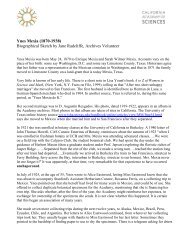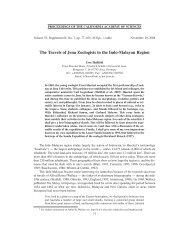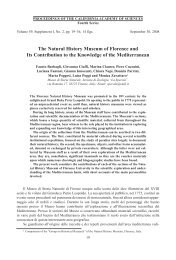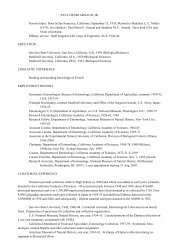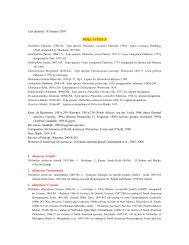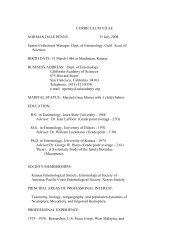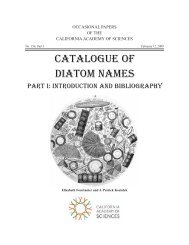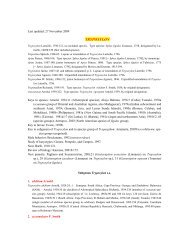Cimino&Ghiselin-tmpZXYZ:Template Proceedings_1.qxd.qxd
Cimino&Ghiselin-tmpZXYZ:Template Proceedings_1.qxd.qxd
Cimino&Ghiselin-tmpZXYZ:Template Proceedings_1.qxd.qxd
Create successful ePaper yourself
Turn your PDF publications into a flip-book with our unique Google optimized e-Paper software.
208 PROCEEDINGS OF THE CALIFORNIA ACADEMY OF SCIENCES<br />
Series 4, Volume 60, No. 10<br />
2005). This is kin selection, or, if you prefer, familial selection (Harvey, Bull, Pemberton & Paxton,<br />
1982). Basically the idea here is that the unit that gets selected is not an organism, but a family unit<br />
made up of close relatives. This would work in such terrestrial animals as butterflies, in which the<br />
larvae (caterpillars) hatch out of eggs that are laid in the same place and then hatch out and grow<br />
up in close proximity to their siblings. If one of them gets eaten by a predator, and if the predator<br />
is repelled, then the remainder of the family will be spared. With most marine gastropods, including<br />
most opisthobranchs, these conditions are not met, as was first pointed out by Faulkner and<br />
<strong>Ghiselin</strong> (1988). Tulrot and Sandberg (1991) provided the same argument. It was further developed<br />
by Rosenberg (1989, 1991). The usual pattern in opisthobranchs is for the fertilized eggs to be laid<br />
in a clutch protected by transparent coverings made up largely of mucopolysaccharide secretion<br />
from the genital duct. The embryos remain in the egg mass while they develop. During that period<br />
they are in close proximity to their siblings, and therefore the conditions for kin selection are in fact<br />
met. Indeed, the eggs of opisthobranchs are often brightly colored and loaded with metabolites as<br />
well. By the end of their embryonic development, however, they hatch out as larvae, swim about<br />
in the water until they find a suitable place for metamorphosis, and settle on the bottom. Only then<br />
do they grow up into mature adults. In consequence, the gene pool gets “stirred up” and the siblings<br />
are separated from one another.<br />
It would appear, then, that the kin or familial mechanism of selection will not work. But things<br />
are not all that straight forward after all (Cimino & <strong>Ghiselin</strong>, 2001). Opisthobranchs, although they<br />
are simultaneous hermaphrodites, generally do not self-fertilize. They fertilize their eggs with<br />
sperm from the prospective father that is stored in a special organ (receptaculum seminis) until the<br />
mother fertilizes the eggs. More sperm than are necessary for fertilization are produced, and some<br />
of the partner’s sperm may be digested in an organ called the gametolytic gland or bursa copulatrix.<br />
This allows for a kind of recycling, allowing the sperm-donors to contribute to the next generation<br />
but bringing about sperm competition among them. The animals tend to congregate in small<br />
groups, and they may copulate repeatedly. Sometimes, as in the case of Notaspidea, they can be<br />
found in the field living as pairs. The body of any such animal that has copulated contains not only<br />
his and her own germ plasm in the form of unfertilized eggs, but also that of other individuals in<br />
the form of viable sperm. Consequently, from a Darwinian point of view a dead opisthobranch is<br />
still very much alive, so long as the sperm are capable of engendering offspring.<br />
Perhaps the best way to close this methodological excursus is to emphasize the point that quite<br />
a variety of evidence can be brought to bear upon the problems of adaptive significance.<br />
Experiments, whether in the field or the laboratory, comparisons whether of behavior or anatomy,<br />
and the historical data of biogeography and phylogenetics all provide useful evidence and lend one<br />
another mutual support.<br />
CHAPTER III<br />
PRODUCERS AND TRANSFORMERS OF SECONDARY METABOLITES<br />
Part 1. Introduction<br />
Although many opisthobranchs biosynthesize defensive metabolites de novo, their doing so is<br />
a later evolutionary development. Originally they obtained the metabolites from food, and this<br />
remains the general rule. Therefore some background material on the organisms from which the<br />
metabolites are obtained will be useful in helping us understand the evolution of chemical defense




